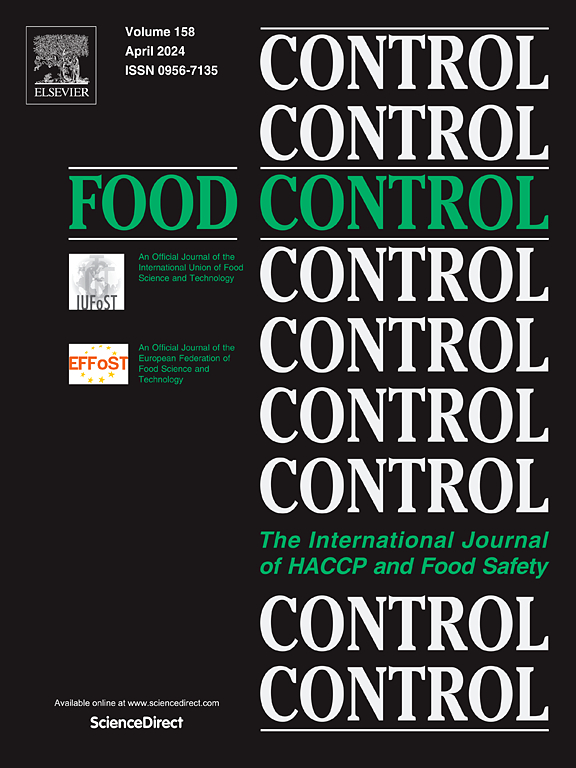Classification and identification of chicken-derived adulteration in pork patties: A multi-dimensional quality profile and machine learning-based approach
IF 5.6
1区 农林科学
Q1 FOOD SCIENCE & TECHNOLOGY
引用次数: 0
Abstract
The purpose of this study was to identify pork patty samples with different levels of chicken adulteration utilizing machine learning techniques. A multi-dimensional detection system was constructed using 300 samples comprising 0 %–100 % chicken adulteration gradients. Forty-three parameters, including water activity, color, texture properties, free amino acids, and electronic nose sensor responses, were analyzed. The physical and chemical changes in pork patties caused by adulteration were systematically analyzed. Machine learning models, such as partial least squares discriminant analysis (PLS-DA), support vector machines (SVM), and back-propagation artificial neural networks (BP-ANN), were developed and evaluated based on quality indices and adulteration rates. The BP-ANN model achieved 99.52 % training accuracy, with an independent test set accuracy of 98.00 %. This performance was significantly superior to that of SVM (95.56 %) and PLS-DA (86.75 %). Shapley Additive Explanations (SHAP) analysis identified threonine content (Thr), chroma parameter (C∗), and histidine content (His) as the primary discriminant indices. The six screening features (L∗, C∗, S12, Thr, Lys, His) combined with the electronic nose sensor array S5, S11, S13, S14 collectively enhanced model robustness. The BP-ANN algorithm was integrated into the Streamlit platform to develop a real-time online tool for predicting adulteration rates.
猪肉肉饼中鸡源掺假的分类和鉴定:多维质量概况和基于机器学习的方法
本研究的目的是利用机器学习技术识别不同鸡肉掺假水平的猪肉肉饼样品。以300份样品为样本,以0 ~ 100%鸡肉掺假梯度构建了多维度检测系统。分析了43个参数,包括水活度、颜色、质地、游离氨基酸和电子鼻传感器响应。系统分析了掺假猪肉肉饼的理化变化。开发了偏最小二乘判别分析(PLS-DA)、支持向量机(SVM)和反向传播人工神经网络(BP-ANN)等机器学习模型,并基于质量指标和掺假率进行了评估。BP-ANN模型的训练准确率达到99.52%,独立测试集准确率达到98.00%。该性能明显优于SVM(95.56%)和PLS-DA(86.75%)。Shapley加性解释(SHAP)分析确定苏氨酸含量(Thr)、色度参数(C *)和组氨酸含量(His)为主要判别指标。6个筛选特征(L∗,C∗,S12, Thr, Lys, His)与电子鼻传感器阵列S5, S11, S13, S14共同增强了模型的鲁棒性。BP-ANN算法被集成到Streamlit平台中,以开发预测掺假率的实时在线工具。
本文章由计算机程序翻译,如有差异,请以英文原文为准。
求助全文
约1分钟内获得全文
求助全文
来源期刊

Food Control
工程技术-食品科技
CiteScore
12.20
自引率
6.70%
发文量
758
审稿时长
33 days
期刊介绍:
Food Control is an international journal that provides essential information for those involved in food safety and process control.
Food Control covers the below areas that relate to food process control or to food safety of human foods:
• Microbial food safety and antimicrobial systems
• Mycotoxins
• Hazard analysis, HACCP and food safety objectives
• Risk assessment, including microbial and chemical hazards
• Quality assurance
• Good manufacturing practices
• Food process systems design and control
• Food Packaging technology and materials in contact with foods
• Rapid methods of analysis and detection, including sensor technology
• Codes of practice, legislation and international harmonization
• Consumer issues
• Education, training and research needs.
The scope of Food Control is comprehensive and includes original research papers, authoritative reviews, short communications, comment articles that report on new developments in food control, and position papers.
 求助内容:
求助内容: 应助结果提醒方式:
应助结果提醒方式:


